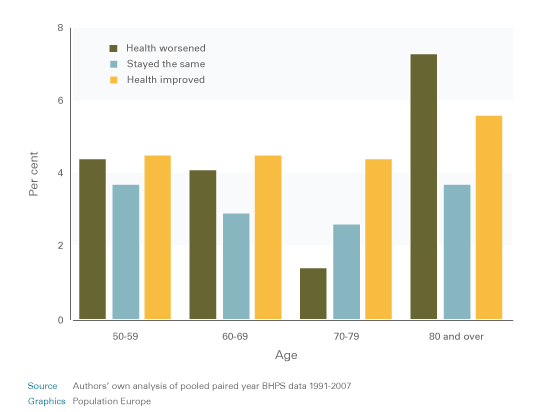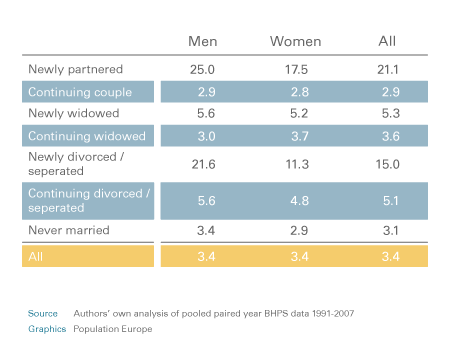Around 3.5 percent of all British people aged 50+ change residences over the course of a given year. While this number has remained relatively constant across time, some of the reasons behind these moves are changing. A new study by Maria Evandrou, Jane C. Falkingham, and Marcus Green explains how more frequent divorces and remarriages, in addition to changes in health and economic status, are creating different migration patterns for those in the later years of life.
Drawing from the responses of more than 70,000 U.K. residents over the age of 50, collected from the British Household Panel Survey (BHPS) over the period 1991-2007, the authors of this study track the motivations behind residential moves among older people. In addition to illustrating how health and income influence migration, they uncover a new finding: As divorce and remarriage become more common later in life, 'relationship driven migration' is becoming more important.
Both better and worse health lead to migration
The authors' analysis of the BHPS data demonstrates that poor health triggers greater residential movement at most ages (figure 1). But better health also seems to play a role: Men and women from 50 to 69 years of age whose health has improved are just as likely to change residences as those whose health has deteriorated, and from age 70 to 79, migration is highest among those whose health improved. Two explanations – which differ in their direction of causation – for the relationship between better health and migration are conceivable: On the one hand, a move could result in a greater sense of well-being. Alternatively, improved health may have facilitated the move.

Figure 1 – Both improvements and deteriorations in health are related to higher residential movement. Proportion of people aged 50-59, 60-69, 70-79, and 80+ moving (in %) whose health improved, worsened or stayed the same.
Income's important…but not that important
Much of the former research surrounding migration of older people explores how money influences moves - when people have less money, they are more likely to move closer to their families or other support systems. Analysis of BHPS data found no significant difference in the level of migration for those aged over 50 according to income. The only exception was in the age range of 60 to 69, in which those in the poorest 20 percent were less likely to move than the age group as a whole. The authors suggest that finances may play a role in facilitating moves around the time of retirement, but they do not play such an important role in the UK at other stages.
New partners, new places
One of the most unusual findings uncovered by the authors was how social norms are changing among older adults. As divorces and remarriages become more common, these new partnerships and breaks translate into more residential mobility. The percentage of residentially mobile older adults who entered into a new partnership is about seven times higher than the percentage of those who have never married. For those who are divorced or separated, the percentage is nearly five times higher (table 1).

Table 1 - A new separation or a new partnership leads to more migration. Percentages of people aged 50 and over that migrated between successive years, by partnership status at time of second interview.
Table 1 also demonstrates how a separation or a breakup will continue to influence residential moves beyond the first year, with those women and men who are continuing divorcees or separatees nearly as likely to move as those who are newly widowed.
In the past, residential moves among older people were examined primarily with a focus on economic and health factors. But, as the authors demonstrate, the importance of relationship patterns and partnering is increasing. Policy makers and planners need to take into account the health and financial status of the older population, but also to recognise the role that relationships play in migration.
This volume has been published with financial support of the European Union in the framework of Population Europe.